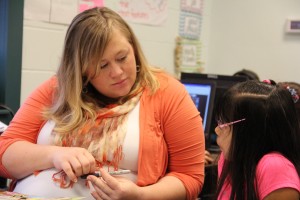Why ‘Less Is More’ For A Rural Florida School Preparing For Common Core

Jackie Mader / The Hechinger Report
Casi Adkinson, a teacher at West Defuniak Elementary listens as a student explains her answer during morning group work.
In Defuniak Springs in Florida’s panhandle, the third graders at West Defuniak Elementary are learning division.
Specifically, 72 divided by six. Their teacher, Casi Adkinson drew circles onto the board.
“I share my 72 into my six circles,” Adkinson said. “Are we ready to do that together? Ready? 1,2,3,4,5…”
With the class counting along, Adkinson drew 72 marks, grouped into six separate circles.
“Ok, I shared my 72,” she said. “What do I do next? Alaya?
“Oh! You count how many there are in the six circles,” Alaya said.
By the time the lesson is over, the class finished only four problems.
“I know to some people, they might think ‘that’s not many problems, I’d want to cover 20,’” Adkinson said. “It doesn’t matter if you cover 20 problems if they don’t understand why they’re doing it.”
The idea of ‘less is more’ has permeated West Defuniak Elementary since 2011. That’s when the school began to phase in the new Common Core standards with its youngest students.
The standards lay out what students are expected to learn from kindergarten through twelfth grade. That’s led to big changes in this rural district.
Students are reading more non-fiction, and must use evidence to back up written responses. In math, students have to learn more than one way to solve the same problem, and they must explain their methods.
“To solve it I drew one big circle,” Ava said, “and I put the number nine in it and I know we’re dividing by three so I put three groups and then I counted to nine and made them all equal and it equaled three.”
Eight-year-old Ava’s attempt to divide 9 by 3 has taken over an entire sheet of paper. Ava’s ability to show her work, also showed Adkinson that the new standards are helping students understand the material on a deeper level.
“Last year it would have been ‘Are you going to multiply or divide? ‘Multiply?’ Awesome, correct answer,” she said. “Now I want them to provide evidence. I want them to prove to me why they’re doing what they’re doing.”
Although many teachers are optimistic about the new standards, they are also cautious about rolling out too much too soon.
This spring, kids in grades three through twelve will be tested on the old standards. That means teachers like Adkinson are teaching a hybrid. She said the district has been careful in planning when each concept will be taught.
“The FCAT is — its very important that they are prepared for it,” she said. “We don’t want to teach them something that’s going to either confuse them…But we also have to prepare for Common Core coming because next year, it’s full implementation.
“We have just made sure that what we’re teaching is what’s going to prepare them for that assessment.”

Jackie Mader
Students in Casi Adkinson's third grade class at West Defuniak Elementary participate in a math lesson.
The community has mostly welcomed the new standards. But West Defuniak principal Darlene Paul said some parents are worried that test scores and grades will drop as harder standards are introduced.
“The concern is that students are making A’s and B’s in Kindergarten and first grade,” Paul said, “and somewhere where we hit second grade and the rigor makes a jump, and their children are not making those grades anymore, they might have a B or a C, then that becomes a big concern.”
Paul has other worries too.
The new Common Core tests will be on computers, which means students will need to be familiar with technology that many of them do not have. West Defuniak serves about 650 students in kindergarten through fifth grade. More than 70 percent qualify for free or reduced lunch.
“Everyone doesn’t have an iPad,” she said. “Everyone at home is not able to get on the Internet. Those are some of our barriers and challenges.”
Next year, there could be even more challenges for teachers who are just now becoming familiar with the standards. The state Board of Education recently approved nearly 100 changes for the Common Core.
Editor’s note: Jackie Mader is a reporter with The Hechinger Report. This story is part of a series from The Hechinger Report and StateImpact Florida looking at how Florida schools are getting ready for Common Core standards.

